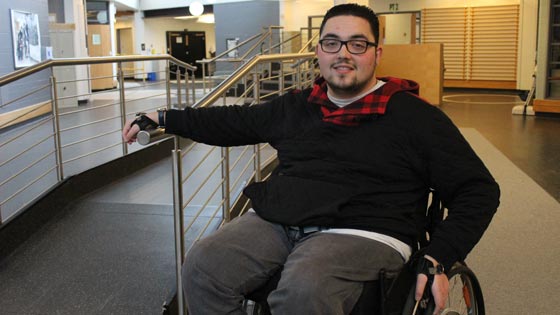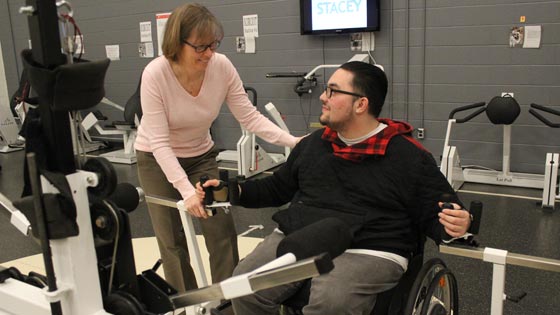
After a swimming accident that left Anthony Simas without function in his legs, the former Toronto Rehab patient has become an advocate for people with spinal cord injuries. (Photo: UHN)
Like most teenagers, 17-year-old Anthony Simas couldn't wait for summer vacation. He had just finished celebrating his high school graduation and prom.
But that summer, a swimming accident would change everything.
While vacationing at a cottage, Anthony slipped off the pool deck, into the water and landed on his head, breaking his neck.
Related to this story
A new standard-of-care for spinal cord injury patients
Today, 20-year-old Anthony is a C5 incomplete quadriplegic. While he has full head and neck movement and muscle range in his upper-body, he has lost function in his legs. His experience has inspired him to become an advocate for spinal cord patients.
From January to March 2015, he partnered with
Toronto Rehab's Lyndhurst Centre and
UHN OpenLab as a Patient Advisor to develop and launch the Spinal Cord Injury rehab version of a Patient Oriented Discharge Summary (PODS) — a tool that facilitates a more patient-centred discharge for spinal cord injury patients during the transition from hospital to home.
PODS summarizes a patient's care plan, signs and symptoms, appointments and contacts for the two-to-four-week period immediately following discharge. It's completed in a "teach-back" style meeting with a patient-driven approach.
One week prior to discharge, the patient meets with a member of their health care team and a neutral facilitator to review their plan for transition into the community. The neutral facilitator has the clinical knowledge to evaluate the plan and determine whether gaps exist.
In January 2016, the pilot program transformed into a new standard-of-care at Lyndhurst Centre, making it the first self-management tool of its kind in Canada for spinal cord injury patients using PODS in a teach-back style meeting.

Sandra Mills, Patient and Family Educator at Toronto Rehab and Patient-Oriented Discharge Summary (PODS) project co-lead (left) with Anthony Simas, former patient at Lyndhurst Centre and Patient Advisor on the PODS pilot project.(Photo: UHN)
'Accepting that life will be different than it was before'
Lyndhurst Centre,
one of five Toronto Rehab sites, is a leader in revolutionizing rehabilitation for people with spinal cord injuries and sees about 325 inpatients per year.
After a 50 to 60-day stay of intensive rehabilitation therapy, patients are discharged back home and into the community. This often results in an overwhelming and stressful experience for patients who will be expected to take care of themselves or rely on family and friends for the first time since their injury.
"There are so many physical and emotional challenges for patients returning home, and sometimes they have not begun the process of grieving the loss of their mobility," says Sandra Mills, Patient and Family Educator at Toronto Rehab and a PODS project co-lead.
"They've participated in intensive rehab where healthcare professionals are readily available. Going home post-injury is a huge adjustment and accepting that life will be different than it was before is part of the adjustment process."
PODS helps patients bridge this gap, ensuring they have the information and resources quickly available to support their transition, including a short-term care plan, medications that need to be taken, signs, symptoms and how to manage pain, outpatient referrals, follow-up appointments, and a telephone contact list.
Results from the pilot program showed that PODS participants' confidence around being discharged doubled in comparison to those who were discharged before the study began.
Patients as partners in care
During the pilot program, Anthony and former Lyndhurst patient Josh Forbes acted as patient advisors, contributing to the conversation around the needs of patients at the time of discharge.
Anthony wishes something more formal would have been in place when he was transitioning home.
"There are so many things to consider once you're on your own but you don't think to ask until you're faced with the situation – for example, whether you know how to jump a curb, roll up and down ramps or what to do if your wheelchair breaks down." – Anthony Simas, Patient Advisor on PODS
"It's also a lot easier to speak with another person with a spinal cord injury about more sensitive topics like catheterization. Having the support of a patient advisor in your discharge meeting offers a sense of comfort and support that you wouldn't get otherwise."
While Anthony and Josh attended and participated in PODS meetings during the pilot project, this hasn't been formally adopted in the current program.
The PODS project team has submitted a funding application to conduct a three-year research study to examine the impact of PODS including the benefits of patient advisor participation during PODS meetings. The hope is to make patient advisors a permanent fixture in the program should study results reflect a significant benefit in the discharge process.
"Before PODS, there wasn't an opportunity to properly consolidate and connect the dots on all of the information a patient requires after discharge," says Heather Flett, Advanced Practice Leader in Spinal Cord Rehab at Toronto Rehab and a PODS project co-lead.
"Our hope is that other spinal cord centres might also be interested in adopting this practice so we can better support patients transitioning back into the community and adjusting to life after injury."
Learn more about PODS.
